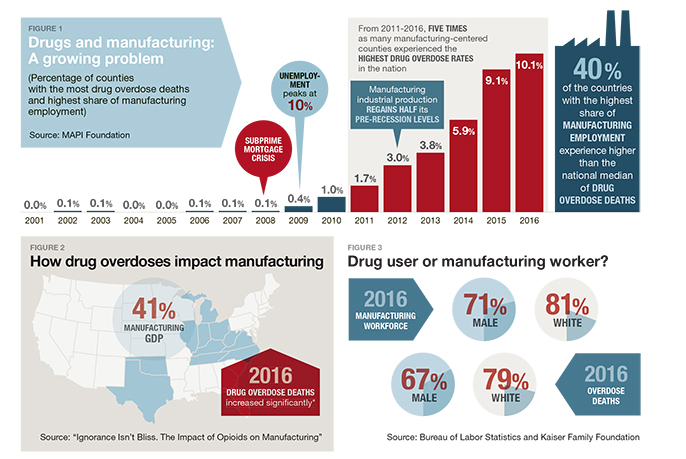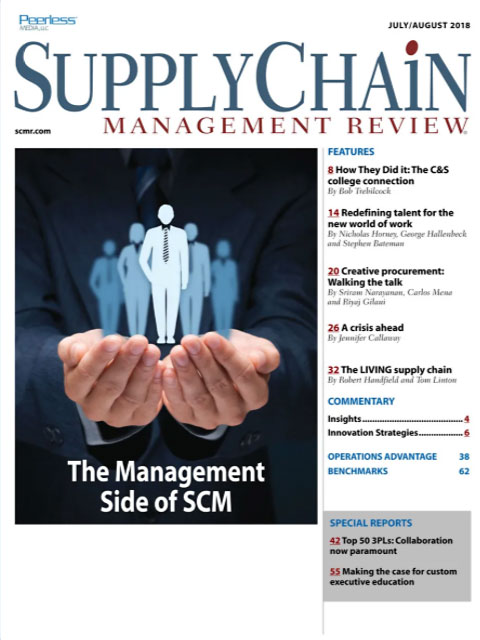Sorry, but your login has failed. Please recheck your login information and resubmit. If your subscription has expired, renew here.
July-August 2018
At Supply Chain Management Review, we’ve been writing about the talent crisis in our profession since at least 2012 when our MIT contributors were publishing a column on talent strategies. Last winter, the topic touched home when I picked up my local newspaper one Saturday morning. One of the lead stories was about two initiatives launched by C&S Wholesale Grocers with two local academic institutions: Keene State College and Franklin Pierce University. Browse this issue archive.Need Help? Contact customer service 847-559-7581 More options
The United States is in the midst of its third drug crisis in the last 50 years. The statistics are bleak: In 2016, drug overdose deaths from opioids increased fivefold compared to 1999. Drugs are now more fatal than car accidents were at their peak in 1972, than guns at their peak in 1993 and AIDS at its peak in 1995. Drug overdoses also killed more people in 2016 than the total number of U.S. soldiers who died during the entire Vietnam War. But here is a sobering statistic particularly relevant to manufacturers and supply chain managers: Drugs are now the leading cause of death for prime working age Americans, those who might otherwise be manning our assembly lines, warehouses and logistics departments.
The culprit is the opioid crisis; two-thirds of drug overdose deaths in 2016 involved a prescription or illicit opioid. The economic and societal implications of this crisis are broad and deep. Altarum, a nonprofit health research and consulting institute, estimates the total cost to the country since 2001 atmore than $1 trillion. In 2015 alone, the United States spent 2.8% of its GDP on the opioid crisis, according to The White House Council of Economic advisers. It also leads to lost tax revenue because opioid users may not be working to their full earning potential—or working at all. There are also social costs: Opioid abuse puts pressure on the criminal justice system due to increased policing efforts, associated legal efforts and correctional facility costs. The Social Security Administration doesn’t grant disability for drug addiction, but misuse of pain medication can lengthen disability claims.

While statistics like those might be familiar to anyone who has followed the opioid crisis in the news, on the campaign trail or in their communities, lost in the discussion is the impact of the current drug crisis on the workforce and productivity in general and its threat to manufacturing.

This complete article is available to subscribers only.
Log in now for full access or start your PLUS+ subscription for instant access.
SC
MR
Sorry, but your login has failed. Please recheck your login information and resubmit. If your subscription has expired, renew here.
July-August 2018
At Supply Chain Management Review, we’ve been writing about the talent crisis in our profession since at least 2012 when our MIT contributors were publishing a column on talent strategies. Last winter, the topic… Browse this issue archive. Access your online digital edition. Download a PDF file of the July-August 2018 issue.The United States is in the midst of its third drug crisis in the last 50 years. The statistics are bleak: In 2016, drug overdose deaths from opioids increased fivefold compared to 1999. Drugs are now more fatal than car accidents were at their peak in 1972, than guns at their peak in 1993 and AIDS at its peak in 1995. Drug overdoses also killed more people in 2016 than the total number of U.S. soldiers who died during the entire Vietnam War. But here is a sobering statistic particularly relevant to manufacturers and supply chain managers: Drugs are now the leading cause of death for prime working age Americans, those who might otherwise be manning our assembly lines, warehouses and logistics departments.
The culprit is the opioid crisis; two-thirds of drug overdose deaths in 2016 involved a prescription or illicit opioid. The economic and societal implications of this crisis are broad and deep. Altarum, a nonprofit health research and consulting institute, estimates the total cost to the country since 2001 atmore than $1 trillion. In 2015 alone, the United States spent 2.8% of its GDP on the opioid crisis, according to The White House Council of Economic advisers. It also leads to lost tax revenue because opioid users may not be working to their full earning potential—or working at all. There are also social costs: Opioid abuse puts pressure on the criminal justice system due to increased policing efforts, associated legal efforts and correctional facility costs. The Social Security Administration doesn't grant disability for drug addiction, but misuse of pain medication can lengthen disability claims.

While statistics like those might be familiar to anyone who has followed the opioid crisis in the news, on the campaign trail or in their communities, lost in the discussion is the impact of the current drug crisis on the workforce and productivity in general and its threat to manufacturing.
SC
MR


Latest Supply Chain News
- Survey reveals strategies for addressing supply chain, logistics labor shortages
- Israel, Ukraine aid package to increase pressure on aerospace and defense supply chains
- How CPG brands can deliver on supplier diversity promises
- How S&OP provides the answer to in-demand products
- AI, virtual reality is bringing experiential learning into the modern age
- More News
Latest Podcast

 Explore
Explore
Procurement & Sourcing News
- Israel, Ukraine aid package to increase pressure on aerospace and defense supply chains
- How CPG brands can deliver on supplier diversity promises
- How S&OP provides the answer to in-demand products
- There is still work to do to achieve supply chain stability
- Blooming success: The vital role of S&OE in nurturing global supply chains
- How one small part held up shipments of thousands of autos
- More Procurement & Sourcing
Latest Procurement & Sourcing Resources

Subscribe

Supply Chain Management Review delivers the best industry content.

Editors’ Picks






